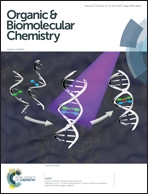Design, synthesis and biological evaluation of novel peptide MC2 analogues from Momordica charantia as potential anti-diabetic agents†
Abstract
Three series of Momordica charantia (MC)2 analogues were designed, synthesized and evaluated for their anti-hyperglycaemic effects. Alanine scanning focusing on the peptide MC2 indicated the importance of the residues proline (Pro)3, serine (Ser)6, isoleucine (Ile)7 and Ser10 for anti-hyperglycaemic effects. Among the first series of MC2 analogues, peptide I-4 exhibited a better anti-hyperglycaemic effect and was chosen for further modification. A further two series of conformationally constrained analogues were designed by scanning the residues Pro3, Ser6, Ile7, and Ser10 with an i − (i + 2) lactam bridge consisting of a glutamic acid-Xaa-lysine (Glu-Xaa-Lys) scaffold and a diproline fragment. By screening in normal mice and mice with diabetes mellitus, peptides II-1, II-2 and III-3 showed a significant improvement in anti-hyperglycaemic and anti-oxidative activities compared with I-4. These data suggest that II-1, II-2 and III-3 could be candidates for future treatment of diabetes mellitus.


 Please wait while we load your content...
Please wait while we load your content...